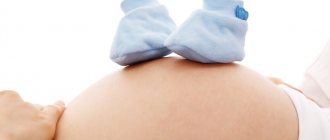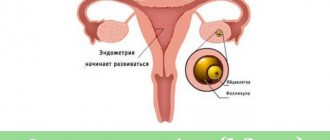Preparing for childbirth
Of course, childbirth is a natural process, but preparation for this important and responsible moment is necessary.
Proper preparation for childbirth will prevent physical and emotional stress, reduce the likelihood of complications, and speed up the mother’s recovery process after childbirth. What should this preparation include, what should it be aimed at?
Knowledge. What scares us most is the unknown. Studying the theoretical foundations of childbirth, a detailed explanation of what will happen and how, and medical answers to questions will help get rid of this fear. Such classes should be conducted by an obstetrician-gynecologist, to whom you can ask any questions, share concerns, and clarify any concerns.
Psychological preparation. Psychoprophylactic preparation for childbirth is carried out starting from the first visit of a pregnant woman to the antenatal clinic. However, special classes are carried out from the 30-week period every 10 days - a total of 5 classes. The main task that is solved during psychoprophylactic preparation is the removal of the feeling of fear during childbirth, which reduces the threshold of pain sensitivity.
School of Fathers. Not only mom, but also dad needs preparation - dad will need skills in caring for the baby, massage techniques that he can use while being present during childbirth, and conversations with a psychologist.
Skills. This includes relaxation exercises between contractions, breathing training, which will later reduce pain during childbirth and ease pushing. Massage and self-massage techniques will allow you to help yourself in the initial stages of labor.
In addition to pain relief during childbirth, classes teach pregnant women the correct behavior during childbirth (following all instructions of medical personnel, the ability to push, understanding the need to examine the birth canal by a doctor after childbirth, etc.). This contributes to the normal course and prevention of complications of labor. Sanitary and hygienic training, which is part of the complex of physical and preventive preparation of pregnant women for childbirth, includes issues of lifestyle, work and rest, balanced nutrition, personal hygiene and the use of natural factors that have a beneficial effect on the body.
In addition, it will be useful for the expectant mother to gain skills in caring for a newborn baby and learn the secrets of breastfeeding.
Gymnastics. Physical preparation for childbirth begins in the early stages and continues throughout pregnancy. Exercises and complexes that are accessible and useful to pregnant women can be found in Pilates, callanetics, yoga, and water aerobics. By combining them, an experienced exercise therapy instructor receives an excellent system that helps improve mood and well-being, cope with back and joint pain, optimize metabolism, prepare the body for childbirth and restore shape after childbirth.
All healthy women can do morning exercises, but during pregnancy it is necessary to avoid jumping, running, and lifting weights. Exercises should be feasible, aimed at strengthening the abdominal and perineal muscles, and not cause overstrain or fatigue.
The best option for conducting effective physical education classes is for a pregnant woman to be taught a set of exercises by a methodologist or a specially trained midwife in a antenatal clinic. To check the correctness of the exercises, you need to contact a methodologist at the antenatal clinic once every 2-3 weeks.
Air baths and hydro procedures (showers, wet rubdowns), which are elements of physical culture, are very useful. Systematic physical education during pregnancy contributes to a more favorable course of labor, reduction of perineal ruptures and a significant reduction in complications in the postpartum period.
Biofeedback (biofeedback) method. We will include it as a separate item, because it is unusual and not known to everyone. This is a non-drug, painless and safe method of teaching the mechanisms of self-regulation of any organs and systems, allowing you to consciously use the enormous functional capabilities of the body. The method works great in preparation for childbirth, helping to cope with fears and psycho-emotional stress, master proper breathing, learn to voluntarily relax muscles and reduce pain.
Sources
- Baron-Szabo RC. Upper Barremian-lower Aptian scleractinian corals of central Europe (Schrattenkalk Fm., Helvetic Zone, Austria, Germany, Switzerland). // Zootaxa - 2021 - Vol4960 - N1 - p.zootaxa.4960.1.1; PMID:33903577
- Sun J., Chen Y., Ding Y., Zhong H., Wu M., Liu Z., Ge L. Deposition of resistant bacteria and resistome through FMT in germ-free piglets. // Lett Appl Microbiol - 2021 - Vol - NNULL - p.; PMID:33894059
- Chinain M., Gatti CMI., Darius HT., Quod JP., Tester PA. Ciguatera poisonings: A global review of occurrences and trends. // Harmful Algae - 2021 - Vol102 - NNULL - p.101873; PMID:33875186
- Jacobsen AL. Diversity in conduit and pit structure among extant gymnosperm taxa. // Am J Bot - 2021 - Vol108 - N4 - p.559-570; PMID:33861866
- Caragata EP., Otero LM., Tikhe CV., Barrera R., Dimopoulos G. Microbial Diversity of Adult Aedes aegypti and Water Collected from Different Mosquito Aquatic Habitats in Puerto Rico. // Microb Ecol - 2021 - Vol - NNULL - p.; PMID:33860847
- Lototskaja E., Sahharov O., Piirsoo M., Kala M., Ustav M., Piirsoo A. Cyclic AMP-dependent protein kinase exhibits antagonistic effects on the replication efficiency of different HPV types. // J Virol - 2021 - Vol - NNULL - p.; PMID:33853963
- Sun ZZ., Ji BW., Zheng N., Wang M., Cao Y., Wan L., Li YS., Rong JC., He HL., Chen XL., Zhang YZ., Xie BB. Phylogenetic Distribution of Polysaccharide-Degrading Enzymes in Marine Bacteria. // Front Microbiol - 2021 - Vol12 - NNULL - p.658620; PMID:33815349
- Dong Y., Li Y., He P., Wang Z., Fan S., Zhang Z., Zhang X., Xu Q. Gut Microbial Composition and Diversity in Four Ophiuroid Species: Divergence Between Suspension Feeder and Scavenger and Their Symbiotic Microbes. // Front Microbiol - 2021 - Vol12 - NNULL - p.645070; PMID:33815331
- Kuźniar A., Włodarczyk K., Sadok I., Staniszewska M., Woźniak M., Furtak K., Grządziel J., Gałązka A., Skórzyńska-Polit E., Wolińska A. A Comprehensive Analysis Using Colorimetry, Liquid Chromatography- Tandem Mass Spectrometry and Bioassays for the Assessment of Indole Related Compounds Produced by Endophytes of Selected Wheat Cultivars. // Molecules - 2021 - Vol26 - N5 - p.; PMID:33807585
- Marter P., Huang S., Brinkmann H., Pradella S., Jarek M., Rohde M., Bunk B., Petersen J. Filling the Gaps in the Cyanobacterial Tree of Life-Metagenome Analysis of Stigonema ocellatum DSM 106950, Chlorogloea purpurea SAG 13.99 and Gomphosphaeria aponina DSM 107014. // Genes (Basel) - 2021 - Vol12 - N3 - p.; PMID:33803228
How does childbirth go?
Almost every woman is afraid to give birth for the first time. It is difficult for her to imagine how it will be, what will actually happen. She doesn’t know how doctors will and should behave; will they do everything right? It is these questions that torment a woman towards the end of pregnancy before the upcoming birth.
The very first advice that can be given to a future mother is to attend a maternity school, which is located at the antenatal clinic, or choose a private school. It is there that they will explain how childbirth goes, how many hours it lasts, what you need to be wary of and how to behave. If the expectant mother did not think about this school at one time, then this article will be especially useful to her.
Harbingers of the first birth
Before giving birth, a woman should pay special attention to her condition: notice when her stomach hurts, how much the pain in the lower back intensifies, this will help her understand that childbirth is very soon. Perhaps the woman will decide to go to the maternity hospital early in order to be in good hands with doctors from the very beginning.
Many people are skeptical about this and do not want to spend time in the hospital, but it is not as bad as it seems. The mother will be calmer if the child’s life is under the control of doctors, especially if there are any indications for premature hospitalization.
Condition before childbirth
- It has become difficult to walk, my lower back hurts
- Insomnia
- Possible loose stools
- The fetus is less mobile
- Poor appetite
- Often there are false contractions - painful, but not regular contractions of the muscles of the uterus
- One or two days before birth, the mucus plug comes off. It looks like stringy and thick mucus
How long does labor last for the first time?
Even before the start of labor, a primigravida woman needs to be prepared for the fact that the first birth lasts from ten to twelve hours. If you are giving birth for the first time, labor will last on average 8-18 hours. Repeated labor lasts less, approximately 5-6 hours. Therefore, you will need to be patient and prepare for long-term contractions. Childbirth is generally divided into three phases.
The first is contractions and dilatation of the cervix. It is the longest.
The second is the expulsion of the fetus.
The third is the birth of the placenta.
First phase
Contractions in a woman giving birth for the first time are strong and long. They usually begin with abdominal pain or severe lower back pain. At first they last for a few seconds, the break is up to 30 minutes. They become painful over a certain period of time. As a result, contractions and pain intensify, and the pause between them shortens. There is a break between contractions, during which time the muscles of the uterus rest, which means they gain strength.
During the period of cervical dilatation, the midwife or doctor will monitor the intensity of contractions, the nature of cervical dilatation, the degree of advancement of the baby's head in the pelvic tunnel, and the condition of the baby. Once your uterus is fully dilated, you will be moved to the delivery room where the next phase of labor will begin, during which your baby will be born. By this time, that is, at the height of labor, contractions repeat every 5-7 minutes and last 40-60 seconds.
Naturally, contractions cannot be stopped; this is a natural process during which the cervix opens. How to cope with painful contractions?
Adviсe
- Before giving birth, you need to learn special breathing that reduces pain during contractions. You need to learn either at school or on your own using video lessons.
- During a contraction, you need to rub your lower back or lightly tap it, this will distract you from the pain.
- You can wash your face with cool water to maintain strength and not become irritated, as you will need strength during childbirth.
When the cervix dilates twelve centimeters, the second phase of labor begins.
Second phase
During the second stage of labor, your baby is born. It is much shorter than the first: 20 - 25 minutes during the first birth and a little less during subsequent ones.
After the cervix has opened completely, the amniotic fluid should rupture under the weight of the amniotic fluid; this is the breaking of the woman’s waters. But still this is not a rule, since the body of all women is different. It happens that the water breaks during contractions. And for some women, their water does not break on their own and, for one reason or another, they have to pierce the amniotic sac using medical instruments. There is no need to be afraid of this, as it is completely painless and will not cause any harm to the child.
As a result of contraction of the uterus and simultaneous contraction of the muscles of the thighs and abdominal wall, pushing begins. That is, the child begins to move along the birth canal. During this period, contractions are joined by pushing - contractions of the muscles of the abdominal wall and diaphragm. The main difference between pushing and contractions is that these are voluntary contractions, that is, they depend on your will: you can delay or intensify them.
With each contraction, the baby's head appears larger and larger, and at a certain point you will be asked not to push, but to breathe quickly and shallowly, since one extra push can now sharply push the baby's head out and cause a rupture of the perineum. After the head comes out, the midwife releases the baby's shoulders one by one, and the rest of the body comes out without difficulty.
Adviсe
- Listen to what the doctor says and follow his commands.
- You can’t get lost, you need to focus on the birth, as you have to work hard.
- You need to think only about the good. The fact that the baby will be born soon, so thoughts of pain need to be driven away.
- Sometimes labor weakens or is not intense enough from the very beginning, this is very dangerous for the child, so if the doctor suggests stimulating medications, you must agree.
After the baby is born, they will cut his umbilical cord, wash him, weigh him and measure his height. For a woman, the birth of a child is not the end of labor, so there is a third stage.
Third phase
After the birth of the child, the woman must give birth to the placenta. This period differs in time for primiparas and multiparas. In primiparous women, the placenta leaves ten or twenty minutes after the baby, and in multiparous women, after a maximum of half an hour. When, after a period of time, the birth of the placenta does not occur, the doctor performs an operation - manual separation of the placenta.
Adviсe
- You need to relax mentally and rest.
- Tell your doctor if there is severe pain anywhere.
- After giving birth, it is imperative, as directed by doctors, to hold ice on the stomach, this will help contract the uterus and stop bleeding.
After this, mother and child will be transferred to a ward, where they will be observed for several days. If all goes well, the newborn and mother will go home on the fifth day. The main thing is not to be afraid and pull yourself together, since a lot depends on the mother’s mood. Childbirth is a natural process that any woman can endure.
Head Configuration
Head configuration represents changes in its shape due to external pressure. A certain configuration of the head may occur before birth, as a result of Braxton-Hicks contractions. The most common form of head configuration is that the parietal bones overlap each other. The head configuration results in a decrease in the minor oblique and an increase in the major oblique diameter of the head. These changes are very important for narrowing of the pelvis and asynclitic insertion of the head. In these circumstances, the ability of the head to change is of great importance in spontaneous vaginal delivery and operative vaginal delivery.
After childbirth
Postpartum department
After childbirth, our patients are placed in the postpartum obstetric physiology department.
The newborn in our maternity hospital is together with the mother in the postpartum department. Pediatric neonatologists and nurses explain and help young mothers learn the rules of caring for a newborn.
The department has single wards with improved living conditions, as well as “Lux” wards, consisting of two rooms, one of which contains a mother and child, the other is intended for guests.
Every day, postpartum women receive training on caring for a newborn, hygiene of the postpartum period, and, if necessary, qualified psychological and legal assistance can be provided.
Vaccination is carried out only with written consent and in the presence of the mother. Children are vaccinated against hepatitis B (in the first 24 hours of a child’s life) and tuberculosis (weakened by the BCG-M vaccine on the 3rd day of life).
Before discharge, all women undergo an ultrasound of the uterus and a clinical blood test. Upon discharge from the maternity hospital, recommendations are given on possible methods of contraception, taking into account the nature of concomitant extragenital diseases and the method of delivery.
With a favorable course of the postpartum period in the mother and the period of early adaptation in the newborn, discharge home occurs on the 3rd day after birth, on the 5th day after cesarean section.
All children are examined according to the program during the 1st month in the pediatric center. In the maternity hospital, it is possible to observe the child under various programs in the pediatric center.
The department has experienced, caring staff who help women easily adapt to their new condition and make caring for their newborn easier.
The team of the postpartum department is a team of like-minded people, in which the exceptional friendliness and respectful attitude of the employees create a particularly warm atmosphere.
Breast-feeding
Our maternity hospital implements a program to “support and encourage breastfeeding”, “technologies” for proper feeding, and provides information about the benefits of natural breastfeeding. The baby is placed on the mother's breast immediately after birth, directly in the delivery room.
A mother's milk is ideal for her baby. It contains a large number of immunoglobulins that protect the child from infections and allergies until his own immune system begins to work at full strength.
Our maternity hospital does not provide supplemental feeding to the baby. It is prescribed only by a neonatologist if the child’s weight loss is greater than is physiologically acceptable, i.e. more than 10% per day.
Milk usually comes in 2-4 days after birth. In the first days after birth, to establish and maintain lactation, you need to drink plenty of fluids (up to 2 liters of fluid per day).
Technology of proper feeding
- The mouth is wide open and the lips are pulled back.
- The nipple is located deep in the newborn's mouth, with its tip in the very back of the mouth.
- The baby's lips and gums are pressed against the areola.
- The lower lip should be turned out. The child should take not only the nipple, but also the isola, more from below than from above.
This technique promotes better emptying of the mammary gland, eliminates injury to the nipples, and also prevents the child from swallowing air.
When breastfeeding, you can eat: meat (lean beef or pork), chicken, turkey, fish (cod or flounder), eggs (2 times a week), porridge (buckwheat, oatmeal, rice), wholemeal bread, butter or vegetable oils, milk, dairy products, vegetables, fruits (bananas, green apples).
When breastfeeding, it is not recommended to eat: red vegetables and fruits (tomatoes, red apples, strawberries, etc.), citrus fruits, sweets, candies, chocolate, seafood, spicy seasonings, garlic, onions, celery. Alcoholic drinks, carbonated drinks, coffee, cocoa.











